The goal of this project was to observe and understand oscillating patterns in a large array of pendulums. This system provides a simple experimental model in which solitons, or something much like them, can be observed. This system was first studied in the Ph.D. dissertation of Denardo1 and in several followup articles, from whom some of our images are borrowed. Prof. Goodman learned about this experimental system in a talk by Victor Sánchez-Morcillo at the LENCOS 2012 conference. It has since been published in Modeling in Science Education and Learning2.
Professor Goodman’s group learned about nonlinear waves, perturbation methods in mechanics, and dynamical systems.
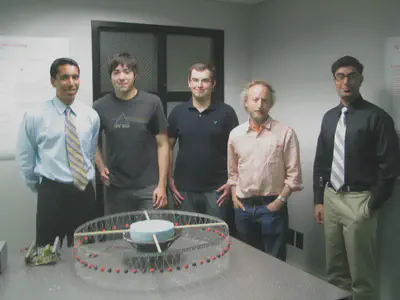
The pendulum is a fundamental object of study in mechanics. Students in their first semester of physics learn that a pendulum of length
where
Most students stop there, but there’s way more to the pendulum than that! In the 1950’s, the Russian physicist Piotr Kapitza demonstrated that rapid vertical oscillation of the pendulum’s support stabilizes the pendulum in the upright direction, a fact which we learned to analyze with the method of averaging, and which we demonstrated by connecting a pendulum to an electric jigsaw, as shown in this video by Mark Levi from Penn State University
Nonlinear effects—those ignored by linearizing the linearized assumption made above—are responsible for much of the interesting behavior seen in pendulums.
Experimental Setup
The pendulums consist simply of beads set on V-shaped strings arranged around a circular metal frame. Each “V” overlaps with, and is attached to, its two nearest neighbors; see schematic below. The entire frame is mounted to a speaker, which oscillates vertically at a frequency specified by an alternating current pattern generator.
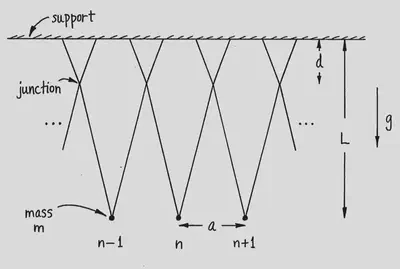
Mathematical Analysis
The damped and parametically-driven pendulum
A single pendulum is driven by vertically oscillating its point of support at about twice the pendulum’s natural frequency. After scaling
The frequency of the driver is chosen to excite the pendulum’s natural frequency of oscillation, with a slight detuning.
The students analyzed this system using the method of multiple scales.
If the pendulum’s natural frequency is sufficiently detuned from that of the driver, specifically if
Array of pendulums
Now we consider an array of pendulums, each with angular displacement
Schrödinger equation
Following Miller 3, we derive an envelope equation which looks for slow variations in the terms
where
For
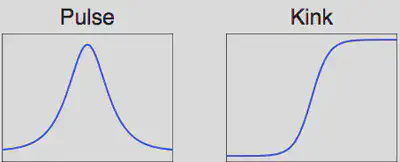
In our experiments, we try to excite various shapes by oscillating the system at twice their oscillatory frequency. We succeeded in finding the kink solutions, but not the pulse solutions.
Experiments
Here is a movie of one experiment. This is at the so-called cutoff frequency, with
And here is the movie after video-processing:
We also show similar movies in which two kinks are present, one near the top, and one on the bottom right. Note that the kinks have a definite width.
See this youtube video:
And this one:
We processed data from these videos using the MATLAB Image Processing Toolbox to find the width and see how it compared with theoretical predictions in Denardo et al. 4
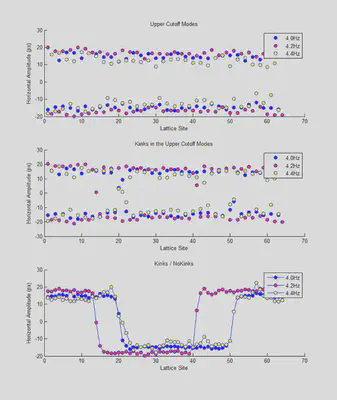
Finally, we performed numerical simulations of the system. We computed kinks at the upper cutoff
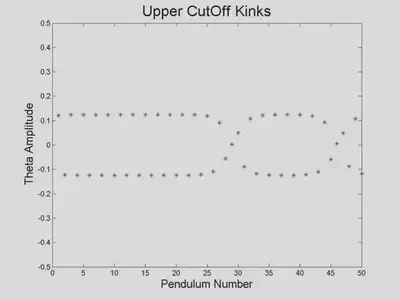
We also foundnd kinks with a wavelength-4 carrier.
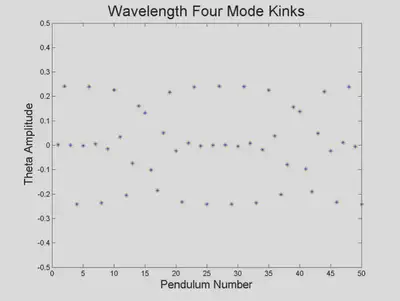
B. C. Denardo, Observations of Nonpropagating Oscillatory Solitons. Ph.D. Thesis, UCLA, Aug. 1990. ↩︎
V. Sánchez-Morcillo, N. Jiménez, N. González, S. Dos Santos, A. Bouakaz, and J. Chaline, “Modeling Acoustically Driven Microbubbles by Macroscopic Discrete-Mechanical Analogues,” Modelling in Science Education and Learning, vol. 6, pp. 75–87, 2013. ↩︎
P. D. Miller. Applied Asymptotic Analysis. American Mathematical Society, 2006. ↩︎
B. Denardo, B. Galvin, A. Greenfield, A. Larraza, S. Putterman, and W. Wright, Observations of localized structures in nonlinear lattices: Domain walls and kinks, Phys. Rev. Lett. 68, pp. 1730–1733, 1992. ↩︎